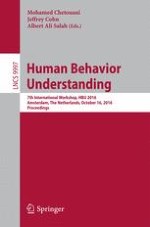2016 | Buch
Human Behavior Understanding
7th International Workshop, HBU 2016, Amsterdam, The Netherlands, October 16, 2016, Proceedings
herausgegeben von: Mohamed Chetouani, Jeffrey Cohn, Albert Ali Salah
Verlag: Springer International Publishing
Buchreihe : Lecture Notes in Computer Science
